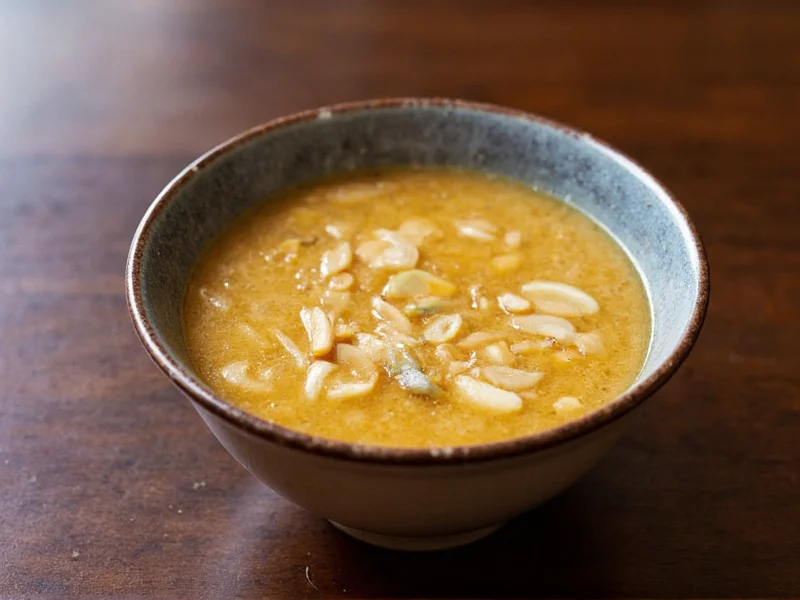Miso soup represents one of Japan's most cherished culinary traditions, served daily in households across the country. This seemingly simple broth carries centuries of culinary wisdom and offers remarkable health benefits when prepared correctly. Understanding what miso soup is made of reveals why it's considered both a comfort food and nutritional powerhouse.
The Foundation: Dashi Broth
Dashi forms the essential base of authentic miso soup. This delicate Japanese stock typically combines:
- Kombu (dried kelp) - provides umami depth
- Bonito flakes (katsuobushi) - adds savory complexity
- Optional additions: dried shiitake mushrooms or dried sardines for regional variations
Traditional dashi preparation requires careful temperature control - never boiling the kombu to avoid bitterness. The resulting broth contains natural glutamates that create that distinctive umami flavor profile central to Japanese cuisine.
Miso Paste: The Heart of the Soup
Miso paste transforms dashi into miso soup. This fermented ingredient comes in several varieties, each affecting the final soup's flavor profile:
| Miso Type | Fermentation Time | Flavor Profile | Best For |
|---|---|---|---|
| Shiromiso (White) | 3-6 months | Sweet, mild | Delicate soups, morning meals |
| Akamiso (Red) | 1-3 years | Salty, robust | Hearty winter soups |
| Mawashimiso (Mixed) | Variable | Balanced | Everyday miso soup |
The fermentation process creates beneficial enzymes and probiotics that support digestive health. Authentic miso contains just soybeans, salt, and koji (a fermentation starter), though regional variations exist.
Essential Additions to Traditional Miso Soup
While minimalism defines traditional miso soup, certain additions have become standard:
- Tofu - Silken tofu cut into small cubes adds protein and texture
- Wakame - Dried seaweed rehydrates in the hot soup, providing minerals
- Green onions - Thinly sliced for fresh aroma and color contrast
These ingredients follow the Japanese culinary principle of washoku - balancing taste, texture, and nutrition in every bowl.
What Makes Authentic Miso Soup Different
Many Western versions miss crucial preparation details that define authentic miso soup:
- Temperature matters - Never boil miso paste (added off-heat at 160°F/70°C max) to preserve probiotics
- Proper miso-to-dashi ratio - Typically 1 tablespoon per cup of dashi
- Regional variations - From Hokkaido's salmon miso to Kyushu's spicy versions
- Seasonal ingredients - Spring might include bamboo shoots, winter features root vegetables
Understanding what miso soup is made of helps avoid common mistakes like overcooking the miso or using inappropriate substitutes that compromise authenticity.
Nutritional Benefits of Properly Made Miso Soup
When prepared with traditional ingredients, miso soup offers remarkable health benefits:
- Rich in probiotics that support gut health
- Contains essential amino acids from fermented soy
- Provides minerals like iodine from seaweed
- Low calorie yet satisfying due to umami compounds
Research shows traditionally fermented miso may support cardiovascular health and contains antioxidants not found in unfermented soy products.
Common Misconceptions About Miso Soup Ingredients
Several myths persist about what miso soup contains:
- Miso soup always contains fish - While traditional dashi uses bonito, vegetarian versions use only kombu and shiitake
- All miso is the same - Different regions produce distinct miso varieties with unique flavors
- Miso soup is just for breakfast - In Japan, it's served with every meal
- Miso paste spoils quickly - Properly stored, miso continues fermenting but remains safe indefinitely
Creating Authentic Miso Soup at Home
For those wondering what miso soup is made of and how to prepare it properly, follow these steps:
- Prepare dashi by steeping kombu in cold water, then adding bonito flakes off-heat
- Strain the dashi and return to low heat (do not boil)
- Dissolve miso paste in a small amount of warm dashi using a suribachi (mortar)
- Add the miso mixture back to the pot off direct heat
- Add tofu and wakame, heat gently without boiling
- Garnish with green onions just before serving
This method preserves the delicate flavors and nutritional benefits that define authentic miso soup ingredients.
Frequently Asked Questions
What are the essential ingredients in traditional miso soup?
Traditional miso soup requires three essential components: dashi (Japanese soup stock made from kombu and bonito flakes), miso paste (fermented soybeans), and common additions like tofu, wakame seaweed, and green onions. The specific type of miso paste used determines whether the soup will be mild (white miso) or robust (red miso).
Can miso soup be made without fish ingredients for vegetarians?
Yes, authentic vegetarian miso soup can be made using kombu dashi (seaweed stock) without bonito flakes. Many Japanese Buddhist temples have prepared vegetarian dashi for centuries using just kombu and dried shiitake mushrooms. This version maintains the essential umami flavor while being completely plant-based.
Why shouldn't you boil miso paste when making soup?
Boiling miso paste destroys its beneficial probiotics and delicate flavor compounds. Authentic preparation involves dissolving the miso in warm (not boiling) dashi off direct heat. The ideal temperature is around 160°F (70°C), which preserves the live cultures and complex flavors developed during fermentation. Boiling also causes the miso to separate and become bitter.
What's the difference between white and red miso in soup?
White miso (shiro miso) ferments for 3-6 months, creating a sweet, mild flavor perfect for delicate morning soups. Red miso (aka miso) ferments 1-3 years, yielding a saltier, more robust flavor ideal for hearty winter soups. The color difference comes from fermentation duration and rice content - longer fermentation creates darker color and stronger flavor. Many home cooks use mixed miso for balanced everyday soup.
How do Japanese households typically customize miso soup ingredients?
Japanese households customize miso soup based on season and region. Common variations include adding clams in coastal areas, mushrooms in mountain regions, or seasonal vegetables like pumpkin in fall. Some regions add a small amount of sake or mirin for depth. The base remains consistent (dashi, miso, tofu, wakame), but supplementary ingredients change with availability and tradition, reflecting Japan's principle of 'shun' - eating with the seasons.











 浙公网安备
33010002000092号
浙公网安备
33010002000092号 浙B2-20120091-4
浙B2-20120091-4